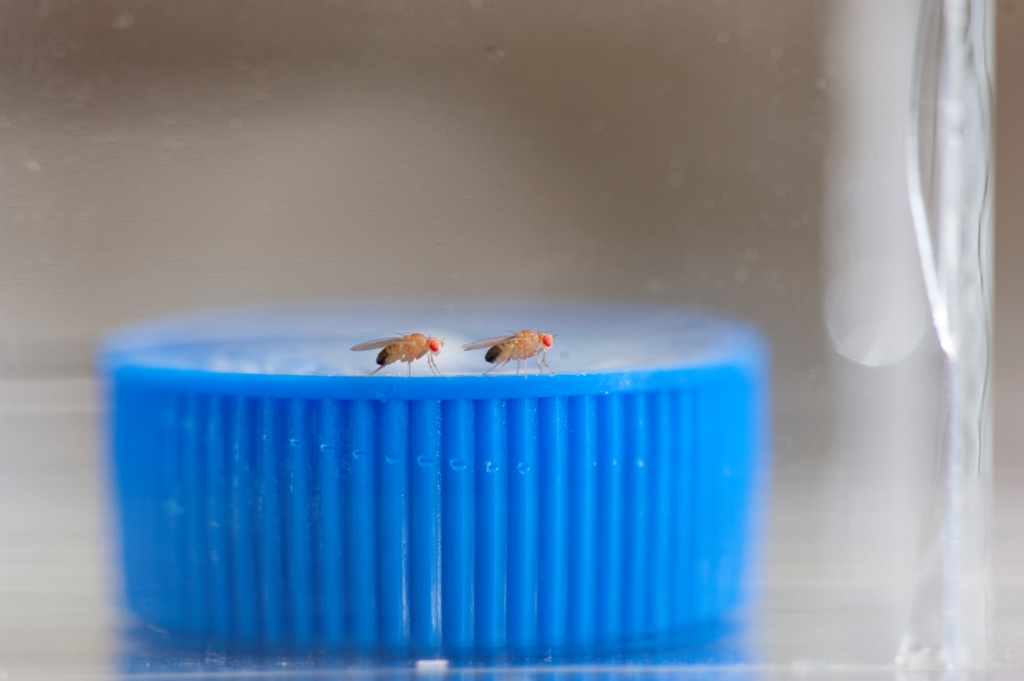By Chris Bryant
Photos by Jeff Hanson
It’s time for another fight inside a large, second floor lab within The University of Alabama’s Science and Engineering Complex.
Boxing announcer Michael Buffer may not be in the house to utter his trademark “Let’s Get Ready to Rumble” decree, but, no matter. UA biology student Austin Hardaway, score card in hand and video camera nearby, is there. And he’s set to record, and later analyze, every blow.
Today’s opponents represent, like always, the flyweight division. And no amount of weight pumping, muscle-burning training will ever elevate them to a higher weight class.
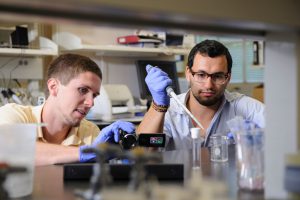
The fighters are fruit flies. And while the upcoming battle between the two flies is real, the war Hardaway and his mentor are interested in winning is the one against autism and its related disorders.
Hardaway, like hundreds of other University of Alabama undergraduates, is immersed in a research project led by a UA faculty member. This junior from Memphis, Tenn. is mentored, for the third year, by Dr. Janis O’Donnell, a UA biologist.
Hardaway and his fellow undergraduates, Matthew Lollar and Ryan Turner, are working on one aspect of a large research project that O’Donnell began collaborating on in 2007. A researcher at another institution was studying genes linked to specific types of Autism Spectrum Disorders, or ASDs, in families and then trying to understand their cellular functions by using fruit flies, O’Donnell recalls.
Those flies, which researchers refer to by their scientific name, Drosophila melanogaster, are simple organisms, but about 75 percent of all human disease genes have a corresponding gene in the genome of the fruit fly, scientists say.
“As we worked, we had ideas,” O’Donnell says, “about how to expand this analysis to a systems biology approach – that is, studying whole networks of genes whose functions interact. We are attempting to identify the sets of genes that may account for one or more of the major areas that characterize the complex disorders associated with various manifestations of an Autism Spectrum Disorder.”
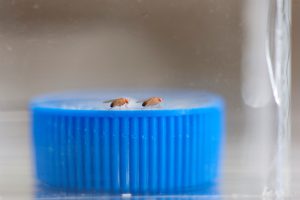
These include repetitive behaviors, aggression, abnormal social interactions, language dysfunction, hyperactivity and learning disabilities.
“Finding the root causes in humans is especially difficult,” O’Donnell says, “because not every person with an autism disorder has all of these characteristics. The combination of a simpler brain structure but similar genes in the fruit fly allows us to directly ask which genes and brain structures are the basis for individual features of autism.”
Identifying those genes and otherwise gaining a better understanding of the genetics behind a disorder can lead to the development of better treatments.
“The trick,” O’Donnell says, “is to work up ways to model the behavioral features of ASD so that we can assess whether specific gene dysfunction can contribute to each ASD behavioral disorder. With flies, one can monitor behavior in a large number of individuals so that a given behavior can be developed into a quantitative assay” or test measurements.
For example, in studying repetitive behaviors, the researchers employ a grooming test.
“Fruit flies actually groom themselves and, in particular genetic strains, they will do so repeatedly,” O’Donnell says. “We simply count the number of events in a particular time period.”
For the aggression tests, the student uses a scoring system to measure the flies’ hostility. Using mutant flies (ones with a defect in a certain gene or genes linked with the production of a specific neurotransmitter in their brains), Hardaway scores the fly fights as a way of measuring aggression levels.
The cellular pathway that is believed to be involved in the production of the neurotransmitter is similar in flies and humans and is one that may not be functioning properly in humans with autism.
Hardaway raises the flies in a test tube, an isolated environment where the aggression results will not be skewed by exposures, for example, to hostile flies. At fight time, Hardaway places two hungry flies in a small “arena,” an enclosure comprised of microscope slides. He places a small amount of yeast paste in the middle of the arena and waits. Each bout is 10 minutes long from the time the flies first contact one another.
“They have different motions,” Hardaway says. “They sometimes rise up on their back legs and box. Sometimes they just lunge. Sometimes one fly will aggressively pursue another fly throughout the arena. They display different levels of aggression.”
And sometimes, Hardaway says, some don’t appear to be aggressive at all. Like the true science that it is, the answers are not easy.
“Sometimes you don’t know if the scenario you are giving them is not provoking enough aggression or if they are just not aggressive.”
Hardaway calls questions like this one the aspect of the project with which he most struggles.
Those types of struggles are the same ones faced by professional scientists, says Dr. Joe Benson, vice president for research at UA. The questions UA undergraduate researchers face don’t have pre-determined solutions, and any progress made is progress toward answers unknown to science.
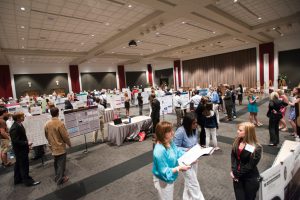
“This is not something where faculty members create a problem and then say, ‘this is how you solve it,’” Benson says. “It’s real research.”
This is what makes the experience both valuable and increasingly popular with UA undergraduates, Benson says.
More than 400 UA undergraduates participated in the University’s spring 2012 research and creative activity conference. That’s up from the just under 300 who participated the previous year. Hardaway and Lollar’s project finished second in their division.
UA’s popular Emerging Scholars Program – designed specifically to attract freshmen to research — is one aspect of the overall undergraduate research experience to which students are drawn.
It’s coordinated by Dr. Ann Webb. She calls the students’ response to the program “gigantic.” By the 2011-2012 academic year, the program’s fifth, there were 253 student participants.
“One of the goals I have for Emerging Scholars is that the students have a good experience, early, and they continue in their research experience,” Webb said. “It’s the faculty and the enthusiasm of the students that make the program go.”
Students in the program are typically asked to devote six to 10 hours a week in a research lab, and they receive small scholarships in exchange.
“I think one of the values of research,” Webb says, “is that it does give the students a feel for what it’s like to be a biologist, or a historian, or a person devoted to the study of communication. This gives students a feel for what it is like to be a professional in a discipline.”
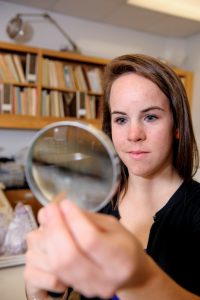
Benson says the program also gives students an immediate sense of belonging, makes them more competitive for national student awards with a research emphasis – honors like the Goldwater or Hollings scholarships – and can sometimes provide faculty with a high-caliber student they can groom into a researcher who can make significant contributions to the lab, down the road.
Erin Smith, a sophomore double-majoring in history and International Studies, joined the Emerging Scholars Program last year as a freshman. She was mentored by Dr. Ian Brown, a UA archaeologist.
“Research is such a big part of the whole college experience,” Smith said. “Last summer I was e-mailed about the program, and I decided it would be a great opportunity. I was interested in research because I have always been interested in archaeology, and it ties into my (history) major.”
In her project, Smith analyzed stone tools and other stone artifacts excavated from an archaeological site near Clarksdale, Miss., in the Mississippi River delta. She studied the 27 “lithic artifacts,” as they are referred to by archaeologists, from the prehistoric Native American site, examining their markings and other features to determine how they were crafted and what could be learned about their likely function.
“At first, I knew nothing about lithic artifacts at all,” Smith recalls. “When I looked at them, it was intimidating because it just looked like a bunch of rocks. My first thought was, ‘what am I getting myself into?’”
Slowly, at first, Smith learned how to analyze the artifacts using a magnifying glass.
“I read a lot of books as I worked on the project and looked at photo examples,” Smith said. “Dr. Brown helped me a lot, and we went over, every week, what I had done.”
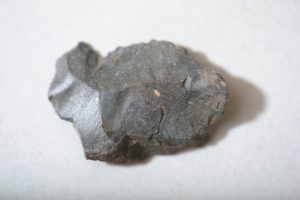
Smith later presented a research poster detailing the work at UA’s annual undergraduate research conference, winning Honorable Mention in the Emerging Scholars program.
“The final paper that she wrote for me was so well done that I shared it with a number of archaeologists working in the Southeast U.S,” Brown says.
After reading the paper, one of those recipients was so impressed he offered Smith a summer position with his archaeological research firm.
Benson, the UA administrator, says when he talks with the students about their research projects, it’s obvious they feel both committed, and accepted, as part of their respective research teams.
“They say, ‘our team is working on …’. It’s not the team,” Benson says. “They consider themselves a part of the group. That’s a very telling statement. The faculty is able to engage them.”
Dr. O’Donnell is a professor of biological sciences while Dr. Brown is a professor of anthropology, both in UA’s College of Arts and Sciences.
